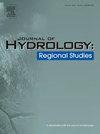Machine learning approaches to identify hydrochemical processes and predict drinking water quality for groundwater environment in a metropolis
IF 4.7
2区 地球科学
Q1 WATER RESOURCES
引用次数: 0
Abstract
Study region
The study area is located in the urban area of Chongqing City, the largest metropolis in southwestern China.
Study focus
Various hydrochemical processes and water quality prediction are unknown, hampering the sustainable development of metropolis. In this study, geochemical model, entropy-weighted water quality index (EWQI), and machine learning (ML) methods were applied to explore the hydrochemical processes and predict the groundwater quality for drinking purposes.
New hydrological insights for the region
The self-organizing map classifies the groundwater samples into 2 clusters. Cluster 1, predominantly located along ridge areas, exhibited HCO3–Ca as the primary hydrochemical facie. Carbonate dissolution, cation exchange processes, and agricultural activities dominated the groundwater chemistry of Cluster 1. HCO3–Ca and HCO3–Na types were the dominant hydrochemical types of Cluster 2 in valley areas. Silicate weathering, cation exchange processes, and domestic sewage were the driving factors controlling the hydrochemistry of Cluster 2. EWQI results showed that 59.48 %, 31.90 % and 8.62 % of samples were excellent, good and medium for drinking, respectively. Four supervised machine learning methods were conducted to predict drinking water quality. Linear regression demonstrated the best correlation of 0.9999. The findings offer invaluable insights into groundwater suitability and evolution processes in a typical population density area and ensure a secure and sustainable domestic water supply worldwide.
求助全文
约1分钟内获得全文
求助全文
来源期刊

Journal of Hydrology-Regional Studies
Earth and Planetary Sciences-Earth and Planetary Sciences (miscellaneous)
CiteScore
6.70
自引率
8.50%
发文量
284
审稿时长
60 days
期刊介绍:
Journal of Hydrology: Regional Studies publishes original research papers enhancing the science of hydrology and aiming at region-specific problems, past and future conditions, analysis, review and solutions. The journal particularly welcomes research papers that deliver new insights into region-specific hydrological processes and responses to changing conditions, as well as contributions that incorporate interdisciplinarity and translational science.
 求助内容:
求助内容: 应助结果提醒方式:
应助结果提醒方式:


